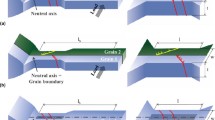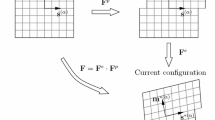Abstract
Silicon is widely used within energy, electro-mechanical, environmental devices by nanostructural control. As silicon parts constitute structural components whose size is ever decreasing, it is critical to understand the mechanical properties of single crystal silicon from precise measurements of load and displacement using microscopic sample in sub-micron and macroscopic scales. Here, the mechanical properties of single crystal silicon were precisely evaluated by bending tests at room temperature using microcantilever beam specimens having a several micron size. The microcantilever beam specimens were prepared using a focused ion beam technique, followed by loading the tip of the specimens. The smaller specimens deformed nonlinearly and then fractured. The unloaded specimen after nonlinear deformation showed permanent strain and many dislocations close to the region where high tensile stress was applied. This means that the nonlinear stress–strain relationship in the very high bending stress is determined by plastic deformation controlled by dislocation despite occurring at room temperature. The bending strength increased with a decrease in specimen size, and the smallest specimens had close to ideal strength. The size of the region where the dislocations accumulated in high density corresponded to the flaw size estimated from the fracture mechanics. This means that the bending strength of the microcantilever beam specimens of silicon is dominated by newly generated defects resulting from dislocations; in other words, the size effect of bending strength of silicon at the micrometer scale is controlled by the accumulation of newly formed dislocations because the dense dislocation region should be lower in a smaller-sized specimen.










Similar content being viewed by others
References
Chen W, Liu Y, Wu J, Chen Q, Zhao Y, Wang Y, Du X (2019) High-efficient solar cells textured by Cu/Ag-cocatalyzed chemical etching on diamond wire sawing multicrystalline silicon. ACS Appl Mater Interfaces 11:10052–10058
Xu ZL, Liu X, Luo Y, Zhou L, Kim JK (2017) Nanosilicon anodes for high performance rechargeable batteries. Prog Mater Sci 90:1–44
Harpak N, Davidi G, Schneier D, Menkin S, Mados E, Golodnitsky D, Peled E, Patolsky F (2019) Large-scale self-catalyzed spongelike silicon nano-network-based 3D anodes for high-capacity lithium-ion batteries. Nano Lett 19:1944–1954
Pandolfi S, Lecuna CR, Godec YL, Baptiste B, Menguy N, Lazzeri M, Gervais C, Spektor K, Crichton WA, Kurakevych OO (2018) Nature of hexagonal silicon forming via high-pressure synthesis: nanostructured hexagonal 4H polytype. Nano Lett 18:5989–5995
Asano K, Tang H, Chen CY, Nagoshi T, Chang TFM, Yamane D, Konishi T, Machida K, Masu K, Sone M (2018) Promoted bending strength in micro-cantilevers composed of nanograined gold toward MEMS applications. Microel Eng 196:20–24
Tang H, Hashigata K, Chang TFM, Chen CY, Nagoshi T, Yamane D, Konishi T, Machida K, Masu K, Sone M (2018) Sample size effect on micro-mechanical properties of gold electroplated with dense carbon dioxide. Surf Coat Technol 350:1065–1070
Dehm G, Jaya BN, Raghavan R, Kirchlechner C (2018) Overview on micro- and nanomechanical testing: new insights in interface plasticity and fracture at small length scales. Acta Mater 142:248–282
Ramezany A, Pourkamali S (2018) Ultrahigh frequency nanomechanical piezoresistive amplifiers for direct channel-selective receiver front-ends. Nano Lett 18:2551–2556
Lu YW, Shieh J, Tsai FY (2016) Induction of ferroelectricity in nanoscale ZrO2/HfO2 bilayer thin films on Pt/Ti/SiO2/Si substrates. Acta Mater 115:68–75
Schlich FF, Spolenak R (2016) Size- and phase-dependent mechanical properties of ultrathin Si films on polyimide substrates. Acta Mater 110:122–130
Cook RF (2006) Strength and sharp contact fracture of silicon. J Mater Sci 41:841–872. https://doi.org/10.1007/s10853-006-6567-y
Jadaan OM, Nemeth NN, Bagdahn J, Sharpe WN Jr (2003) Probabilistic Weibull behavior and mechanical properties of MEMS brittle materials. J Mater Sci 38:4087–4113. https://doi.org/10.1023/A:1026317303377
Hauch JA, Holland D, Marder MP, Swinney HL (1999) Dynamic fracture in single crystal silicon. Phys Rev Lett 82(19):2823–2826
Lawn B (1975) Fracture in brittle solids. Cambridge University Press, Cambridge
Mier JGMV, Vliet MRAV (2003) Influence of microstructure of concrete on size/scale effects in tensile fracture. Eng Fract Mech 70:2281–2306
Östlund F, Malyska KR, Leifer K, Hale L, Tang Y, Ballarini R, Gerberich W, Michler J (2009) Brittle-to-ductile transition in uniaxial compression of silicon pillars at room temperature. Adv Funct Mater 19:2439–2444
Wang YC, Zhang W, Wang LY, Zhuang Z, Ma E, Li J, Shan ZW (2016) In situ TEM study of deformation-induced crystalline-to-amorphous transition in silicon. NPG Asia Mater 8:e291
Wessel K, Alexsander H (1977) On the mobility of partial dislocations in silicon. Philos Mag 35(6):1523–1536
Nishino Y, Saka H, Imura T (1984) Temperature dependence of friction force acting on dislocations in silicon crystals. J Mater Sci 19:245–253. https://doi.org/10.1007/BF02403131
Izumi S, Ohta H, Takahashi C, Suzuki T, Saka H (2010) Shuffle-set dislocation nucleation in semiconductor silicon device. Philos Mag Lett 90(10):707–714
Castaing J, Veyssiere P, Kubin L, Rabier J (1981) The plastic deformation of silicon between 300 and 600 °C. Philos Mag 44(6):1407–1413
Okuno T, Saka H (2013) Electron microscope study of dislocations introduced by deformation in a Si between 77 and 873 K. J Mater Sci 48:115–124. https://doi.org/10.1007/s10853-012-6860-x
Asaoka K, Umeda T, Arai S, Saka H (2005) Direct evidence for shuffle dislocations in Si activated by indentations at 77K. Mater Sci Eng A 400–401:93–96
Ray I, Cockayne D (1971) The dissociation of dislocations in silicon. Proc R Soc A 325:543–554
Rabier J (2007) High-stress plasticity and the core structures of dislocations in silicon. Phys Stat Sol 204(7):2248–2255
Saka H, Yamamoto Y, Arai S, Kuroda K (2006) In-situ TEM observation of transformation of dislocations from shuffle to glide sets in Si under supersaturation of interstitials. Philos Mag 86:4841–4850
William WG, Douglas DS, Aaron RB, Natalia IT (2011) A brittleness transition in silicon due to scale. J Mater Res 27(3):552–561
Elhebeary M, Saif MTA (2018) A novel MEMS stage for in situ thermomechanical testing of single crystal silicon microbeams under bending. Extreme Mech Lett 23:1–8
Balila NJ, Jeffrey MW, Juri W, James PB, Rafael S, Johann M, Christoph K, Gerhard D (2016) Microscale fracture behavior of single crystal silicon beams at elevated temperatures. Nano Lett 16:7597–7603
Wang B, Zhang Z, Chang K, Cui J, Rosenkranz A, Yu J, Lin CT, Chen G, Zang K, Luo J, Jiang N, Guo D (2018) New deformation-induced nanostructure in silicon. Nano Lett 18:4611–4617
Tsuchiya T, Hemmi T, Suzuki J, Hirai Y, Tabata O (2018) Tensile strength of silicon nanowires batch-fabricated into electrostatic MEMS testing device. Appl Sci 8:880
Fugii T, Sudoh K, Inoue S, Namazu T (2016) Design and development of electrostatically driven uniaxial tensile test device for silicon nanowires. Sens Mater 28(2):89–102
Sundararajan S, Bhushan B (2002) Devlopment of AFM-based technique to measure mechanical properties of nanoscale structures. Sens Actuat A 101:338–351
Sundararajan S, Bhushan B, Namazu T, Isono Y (2002) Mechanical property measurements of nanoscale structures using an atomic force microscope. Sens Actuat A 91:111–118
Fujii T, Sudoh K, Sakakihara S, Naito M, Inoue S, Namazu T (2013) Nano-scale tensile testing and sample preparation techniques for silicon nanowires. Jpn J Appl Phys 52:110118
Kang W, Saif MTA (2013) In situ study of size and temperature dependent brittle-to-ductile transition in single crystal silicon. Adv Funct Mater 23:713–719
Tsuchiya T, Hemmi T, Suzuki J, Hirai Y, Tabata O (2016) Tensile fracture of integrated single-crystal silicon nanowire using MEMS electrostatic testing device. Proc Struct Integr 2:1405–1412
Goel S, Kovalchenko A, Stukowski A, Cross G (2016) Influence of microstructure on the cutting behaviour of silicon. Acta Mater 105:464–478
Tang DM, Ren CL, Wang MS, Wei X, Kawamoto N, Liu C, Bando Y, Mitome M, Fukata N, Golberg D (2012) Mechanical properties of Si nanowires as revealed by in situ transmission electron microscopy and molecular dynamics simulations. Nano Lett 12:1898–1904
Wang L, Zheng K, Zhang Z, Han X (2011) Direct atomic-scale imaging about the mechanisms of ultralarge bent straining in Si nanowires. Nano Lett 11:2382–2385
Uesugi A, Hirai Y, Tsuchiya T, Tabata O (2016) Effect of crystallographic orientations on fractures and slip occurrences at 500 °C of (110) single crystal silicon microstructures. Proc Struct Integr 2:1413–1420
Fujita S, Tatami J, Yahagi T, Takahashi T, Iijima M (2017) Degradation evaluation of Si3N4 ceramic surface layer in contact with molten Al using microcantilever beam specimens. J Eur Ceram Soc 37:4351–4356
Tatami J, Katayama M, Ohnishi M, Yahagi T, Takahashi T, Horiuchi T, Yokouchi M, Yasuda K, Kim DK, Wakihara T, Komeya K (2015) Local fracture toughness of Si3N4 ceramics measured using single-edge notched microcantilever beam specimens. J Am Ceram Soc 98(3):965–971
Camposivan E, Anglada M (2016) Size and plasticity effects in zirconia micropillars compression. Acta Mater 103:882–892
Wheeler JM, Ranghavan R, Wehrs J, Zhang Y, Erni R, Michler J (2016) Approaching the limits of strength: measuring the uniaxial compressive strength of diamond at small scales. Nano Lett 16:812–816
Lu Y, Shu X, Liao X (2018) Size effect for achieving high mechanical performance body-centered cubic metals and alloys. Sci China Mater 61(12):1495–1516
Yamaguchi H, Tatami J, Iijima M (2019) Measurement of mechanical properties of BaTiO3 layer in multilayered ceramic capacitor using a microcantilever beam specimen. J Ceram Soc Jpn 127(6):335–338
Colas G, Serles P, Saulot A, Filleter T (2019) Strength measurement and rupture mechnisms of a micron thick nanocrystalline MoS2 coating using AFM based micro-bending test. J Mech Phys Solids 128:151–161
Yoshida K, Nishiyama N, Sone M, Wakai F (2017) Strength and toughness of nanocrystalline SiO2 stishovite toughened by fracture-induced amorphization. Acta Mater 124:316–324
Ronan H, Thierry B, Thierry D, Armel DM, Isabelle ZA, Jean MG, Cyril L, Sylvain M (2019) Local fracture toughness measurements in polycrystalline cubic zirconia using micro-cantilever bending tests. Mech Mater 136:103086
Brantley WA (1973) Calculated elastic constants for stress problems associated with semiconductor devices. J Appl Phys 44(1):534–535
Saka H (2017) Classical theory of crystal dislocations: from iron to gallium nitride. World Scientific, Singapore
Han XD, Zhang YF, Zheng K, Zhang XN, Zhang Z, Hao YJ, Guo XY, Yuan J, Wang ZL (2007) Low-temperature in situ large strain plasticity of ceramic SiC nanowires and its atomic-scale mechanism. Nano Lett 7(2):452–457
Rabier J, Renault PO, Eyidi D, Demenet JL, Chen J, Couvy H, Wang L (2007) Low-temperature in situ large strain plasticity of ceramic SiC nanowires and its atomic-scale mechanism. Phys Stat Sol C 4:3110
Dubois SMM, Rignanese GM, Pardoen T, Charlier JC (2006) Ideal strength of silicon: an ab initio study. Phys Rev B 74:235203
Sumigawa T, Ashida S, Tanaka S, Sanada K, Kitamura T (2015) Fracture toughness of silicon in nanometer-scale singular stress field. Eng Fract Mech 150:161–167
Gallo P, Yan Y, Sumigawa T, Kitamura T (2018) Fracture behavior of nanoscale notched silicon beams investigated by the theory of critical distances. Adv Theory Simul 1:1700006
Gallo P, Sumigawa T, Kitamura T (2019) Experimental characterization at nanoscale of single crystal silicon fracture toughness. Frattura ed Integrità Strutturale 47:408–415
Kunio H, Shinji T, Yasunori O, Tomozo N (1991) Fracture toughness of single crystal silicon. J Soc Mater Sci Jpn 40(451):405–410
Balila NJ, Christoph K, Gerhard D (2014) Can microscale fracture tests provide reliable fracture toughness values? A case study in silicon. J Mater Res 30(5):686–698
Ando T, Li X, Nakano S, Kasai T, Tanaka H, Shikida M, Sato K (2005) Fracture toughness measurement of thin film silicon. Fatigue Fract Eng Mater Struct 28:687–694
Motz C, Schöberl T, Pippan R (2005) Mechanical properties of micro-sized copper bending beams machined by the focused ion beam technique. Acta Mater 53:4269–4279
Jiang BC, Zhao DW, Wang BQ, Zhao HJ, Liu YH, Lu XC (2019) Flatness maintenance and roughness reduction of silicon mirror in chemical mechanical polishing process. Sci China Technol Sci. https://doi.org/10.1007/s11431-018-9414-6
Johannes W (1996) Dislocation based fracture mechanics. World Scientific, Singapore
Acknowledgements
This work was partly supported by JSPS KAKENHI Grant Numbers 17H01319.
Author information
Authors and Affiliations
Corresponding author
Additional information
Publisher's Note
Springer Nature remains neutral with regard to jurisdictional claims in published maps and institutional affiliations.
Electronic supplementary material
Below is the link to the electronic supplementary material.
Rights and permissions
About this article
Cite this article
Yamaguchi, H., Tatami, J., Yahagi, T. et al. Dislocation-controlled microscopic mechanical phenomena in single crystal silicon under bending stress at room temperature. J Mater Sci 55, 7359–7372 (2020). https://doi.org/10.1007/s10853-020-04528-3
Received:
Accepted:
Published:
Issue Date:
DOI: https://doi.org/10.1007/s10853-020-04528-3




